What Hi-Fi? Verdict
A gloriously insightful and musical performer, with more power on tap available than you're ever going to need
Pros
- +
Gorgeous build and power output meters
- +
Hugely revealing performer
- +
Warm, rich and smooth sound
- +
Plenty powerful
Cons
- -
Remote difficult to read in poor light
Why you can trust What Hi-Fi?

This review and test originally appeared in Audio Esoterica magazine, one of What Hi-Fi?’s sister titles from Down Under. Click here for more information about Future publishing's Australian hi-fi and AV titles, including links to buy individual digital editions and details on how best to subscribe.
In some ways, the name of Musical Fidelity’s latest amplifier is a misnomer. The Nu-Vista vacuum tube was indeed a ‘New Vista’ electronic device when it was introduced by RCA in 1959, when it was physically smaller, more robust and exhibited higher performance than anything else available at the time... and indeed, in some applications, for the next 20 years. But it is now 2023. The Nu-Vista is not a new device, and why would Musical Fidelity use an old-fashioned vacuum tube anyway?
Well, it’s for the same reason that valve audio amplifiers have never gone out of production and valves are still used in most musical instrument amplifiers – sound quality. Put a valve in the signal path and music just sounds more musical. Where Musical Fidelity has been smarter than most is, firstly, where it uses valves, which is the input stage, rather than the output stage, because the inherently low voltages mean negligible component stress, in turn meaning that the valve’s life is essentially unlimited. The second smart move was to use Nu-Vistas as opposed to any other valve type because they have proven to not only have a long lifespan but also be exceptionally reliable throughout it, not to mention low noise.
But all of the above was true when Musical Fidelity introduced the original Nu-Vista 800 integrated amplifier back in 2015. If the same Nu-Vista valves are being used (which they are), why the need for a Nu-Vista 800.2 model? Why not just continue with the almost decade-old Nu-Vista 800, not least as it was one of Musical Fidelity’s best-selling amplifiers?
The answer, according to the company’s new owner, Heinz Lichtenegger (who purchased the company from his old friend, Antony Michaelson, who founded it), was that several of the 800’s most important components, including the unique “retro look” display, were discontinued. “We were therefore left with a choice,” he said. “Discontinue a popular amplifier or replace the original with an updated version as unchanged as possible from the original.” Looking at the Nu-Vista 800.2, we can’t exactly agree that it is ‘as unchanged as possible’ because it actually sports a host of changes, all of which offer improvements on the older model.
The most visually obvious change is to the front panel. The new large meters (which replace the previously too-small rectangular display) are absolutely fantastic, but the panel itself has been updated to a totally modern design too, the main difference being that you now can’t see the heat-sink finning that runs down either side of the chassis. This, in our minds, has massively improved the amplifier’s appearance.

Regarding the internals, Musical Fidelity says the two toroidal power transformers that supply the discrete left and right power amplifier sections have been rewound to have lower standing flux, making them less sensitive to mains DC offset noise. This has supposedly also reduced noise in the amplifier. The power supply circuitry itself has been revisited, though this was primarily to enable remote standby switching, which was always an odd omission in the original Nu-Vista 800.
A quick read of the Nu-Vista 800.2’s information brochure would seem to indicate that the 800.2 circuit now includes a locally decoupled output stage, where each output transistor (Musical Fidelity is still using the old Sanken STD03P/03N enhanced Darlington transistors with built-in drivers and temperature compensation it chose for the 800) is equipped with its own capacitor, and mounted very close to it in order to ensure a lower impedance path and thus better transient response and improved ripple filtering during high-current delivery. But a more careful reading of the brochure will reveal that all of this admittedly creative circuit topology was inherent in the 800’s design, so nothing has actually changed here at all.
The latest hi-fi, home cinema and tech news, reviews, buying advice and deals, direct to your inbox.

Power Output (8Ω): 330 watts per channel
Frequency Response: 10Hz–30kHz +0/–0.1dB
S/N Ratio: >107dB ‘A’-weighted
Power Consumption (Standby): <0.5 watts
Power Consumption (Max): 900 watts
Dimensions (HWD): 19 x 48 x 51cm
Weight: 41kg
Like its predecessor, the Nu-Vista 800.2 has five line-level inputs, four of which are unbalanced and use RCA terminals, and one that is balanced and uses XLR connectors. One of the unbalanced inputs (AUX1) can be switched to operate as a home theatre bypass input, the switching for which is done via the very sensible system of using a two-position analogue switch on the rear panel. This is so much better than any other method that we have to give Musical Fidelity bonus points for doing it this way. Other implementations of a home theatre mode we’ve seen leave open the possibility for someone who does not know how to use your amplifier to seriously damage your connected loudspeakers by selecting the mode accidentally. Because Musical Fidelity is using an analogue implementation, with the necessary switch hidden away on the rear panel, accidents like this cannot happen. Simple but brilliant!
As far as outputs are concerned, there are eight speaker terminals (four per channel), though these are internally linked and so, while it might appear that you can connect two pairs of speakers and have A/B speaker switching, you can in fact drive only one pair of loudspeakers. There’s also a line-level output (via RCA), allowing you to send an audio signal to a separate headphone amplifier in the absence of a headphone output on the Nu-Vista 800.2 itself (just as there wasn’t one on the original 800, something we thought might have been worth revisiting on an updated version). The 800.2’s pre-amplifier output could also be used to send signals to another amplifier in another room to enable multi-room operation, or for bi-amplifying a pair of stereo speakers in the same room.
The chunky (178 x 65 x 22mm), full-metal-cased infrared remote control that Musical Fidelity supplies as standard with the Nu-Vista 800.2 (many manufacturers make the remote an optional, added-cost item!) requires two AAA batteries, and while Musical Fidelity provides high-quality, Panasonic alkaline cells, we’d recommend using lithium ones instead.
To make this installation easier, Musical Fidelity does not screw the rear panel onto the remote but instead just tapes it in place and provides the six screws separately, along with a high-quality, Philips-head screwdriver and four tiny, 3M-branded silicon protective bumper feet to stop the metal remote from scratching whatever surface you put it on (or slipping off that surface if it happens to be sloping).

While we appreciate that not having to remove the screws speeds up the battery installation process, we found it very difficult to remove the adhesive tape that keeps the back of the remote in place during transport. Could we venture to suggest that instead of two pieces of tape, perhaps just a single piece right across the back of the remote would make the process easier? And why not fold one end of the tape over itself while you’re at it so that it’s easy to peel off? Or maybe just go low-tech and use a rubber band...
The remote has a lovely non-marking dulled aluminium finish, with its 10 buttons arranged very creatively – in two star-shaped groups of five as opposed to the usual boring grid pattern. Full marks to whoever at Musical Fidelity was responsible for this beautiful geometry! However, the lettering used to identify these buttons uses a paint that is almost (but not quite) the same shade as the colour of the remote itself, which looks ultra-classy but makes it difficult to read in less-than-perfect lighting conditions. (And while we’re having a minor gripe, the six screws that secure the rear panel would look better if they were silvered or stainless. They were rather jarringly black on ours.)
Despite at least two of the reviewers for Audio Esoterica being on record as saying that power output meters on an audio amplifier are nearly always inaccurate, mostly useless in helping assess whether the amp’s output is overpowering your loudspeakers, and ultimately just adding to the cost of the amplifier without adding any real value, we have to say (and to paraphrase Leonard Cohen) that when it comes to the Musical Fidelity Nu-Vista 800.2, “we’ll make an exception”. These are likely the most gorgeous meters we’ve seen on any amplifier, and having watched them for the last few months, we can’t imagine the 800.2 without them.
Unlike some other famous power output meters, which use ‘old’ technology, the two meters on this Musical Fidelity are not old-fashioned (or slow) mechanical meters but are instead solid-state. And unlike some other famous meters, where you get a colour choice of blue or blue (or off!), you can switch the Nu-Vista 800.2’s meters through multiple display formats, colours and illumination modes.
There was some disagreement at Audio Esoterica about the best display mode, but we can advise that Display 4 was nobody’s choice and Display 2 was the most popular. Illumination Mode 7, which is the default mode, was also a preferred choice by most, but as you may have already gathered, your ultimate choice between the seven options on offer will be a personal preference. Our advice, however, would be to choose an option that leaves ‘Base’ lighting circuitry on; otherwise, if you press ‘Mute’ without having a clear view of the Nu-Vista valves at the top rear of the amplifier, you won’t be able to ascertain (at least visually!) whether or not the amp is indeed muted. Leave this lighting on and it will glow red when the amplifier is muted and be obviously visible from anywhere in the listening room.

We should point out that there is an indicator on the front panel display that the amplifier is muted, which is that the dB display will be a different shade of grey to the one shown when it is operating normally, but the shading depends on which display format you’re using! This would initially seem difficult to work out, but it’s actually pretty easy because if the dB display is a different shade to the one showing the selected input immediately to the left, then the amplifier is muted.
Although the Nu-Vista 800.2 powers up and is ready to play music quite quickly (around 10 seconds or so and indicated by the LED light underneath the front panel turning from red to blue), Musical Fidelity says the Nu-Vista valves themselves, although operational from the get-go, will not “reach thermal equilibrium” or “deliver their best performance” for a further 15 minutes, at which point they will be surrounded by a blue glow of LEDs. (However, while the manual says ‘15 minutes’, it always took rather longer during our sessions. During warm-up, the LED for the Nu-Vista valves glows orange.)
Sound
We nearly always kick off our listening sessions at very high listening levels, primarily to ensure that the circuitry is at optimal temperature, despite the fact we always do a warm-up listen before commencing any critical listening. This approach also gives us a chance to evaluate the amount of power an amplifier can deliver to our very inefficient reference loudspeakers, and whether it can cope with their very low impedance at low frequencies.
Happily, we can report that the Nu-Vista 800.2 didn’t give us a moment’s doubt on either front. It was easily able to drive our loudspeakers to higher volume levels than we’d ever dream of using in any situation other than an equipment evaluation session, showing no difficulties at all partnered with our difficult-to-drive speakers. Indeed, we actually connected a second pair of speakers in parallel and drove both pairs simultaneously just to see if we could trick the protection circuitry into tripping – but the Nu-Vista 800.2 just continued powering on, acting and sounding exactly as if it was driving a single speaker pair.
A song that is often used for testing bass is Massive Attack’s Angel, yet it was one we hadn’t previously tried and so decided to give it a whirl. There’s certainly a surfeit of deep bass on this track, and the Nu-Vista 800.2 had no difficulty delivering all of it. Our issue was that the recording isn’t very clean, so although you can hear the depth of the bass it is difficult to quantify its purity. There’s also not much of an instrumental spread and the overall sound is in the grunge category. So we reverted to one of our old favourites, Age Of Consent from New Order’s album ‘Power, Corruption and Lies’. This is a nice clean recording and the Nu-Vista 800.2 demonstrated that in spades, delivering a lovely rendition, with the low frequencies just as they should be in terms of extension, power and purity.
From there it was but a short step to Rage Against The Machine’s self-titled debut album and the homage to deep bass that is spread across its 10 tracks. You know you’re in for a bass-fest right from the outset, with opener Bombtrack setting the scene with its fast, repeated bass riff accompanied by an octave phantom bass in the far background. A bit later, when the drums burst in followed by the rap vocal, we notice how that, despite what’s going on in the bass, the Nu-Vista 800.2 let us hear the diction of the vocal with superb clarity. Needless to say, it is not always this good!

The following track, Killing In The Name, reveals the perfection of the Nu-Vista 800.2’s deep bass delivery even more explicitly: listen to the incredible delivery of the transients, the way you can still hear the cymbals in the background, plus the superb channel separation so that sounds in the left channel stay there; there is zero leakage of sound to the right channel, or vice versa. At the same time, the central image is so tightly fixed centrestage that it’s like it was nailed there. Don’t forget to listen to Bullet In The Head right out to its close-out; it’s one of the best closers we’ve ever heard.
We tested the Nu-Vista 800.2’s midrange performance with the Sofie Von Otter/Elvis Costello collaboration titled ‘For The Stars’. Von Otter’s classically perfect mezzo-soprano voice is captured so superbly on every track that it’s impossible to pick a favourite, but her cover of Baby Plays Around is a standout, not least for its trumpet solo. Kate McGarrigal’s Go Leave is notable for the cello and piano sound behind Van Otter’s voice, too, though don’t miss Green Song either for the sound of bowed and plucked cello.
The production on this album is superb, and we could hear that the Nu-Vista 800.2 not only delivered every single nuance perfectly but also added no noise at all to the music. And the silences were gloriously silent. The way the Musical Fidelity separates the musical elements of Rope was aural magic, while Broken Bicycles added extreme high frequencies for our appreciation.
However, to further evaluate how the Nu-Vista 800.2 handled the highs, we switched to Bonnie Rait’s album ‘Nick Of Time’, which has them by the handful. It also has a glorious selection of instrumental sounds, many played by guests such as Herbie Hancock (I Ain’t Gonna Let You Break My Heart Again) and Chuck Domanico (Cry On My Shoulder). Listen out too for David Crosby and Graham Nash! But it isn’t only the high frequencies that make this album fantastic testing material – it also has that warm, rich and full sound that was popular in the 1970s and 80s. And the amplifier delivers this richness like a complex tapestry.
Verdict
Gloriously smooth and musical sound quality, partly courtesy of trouble-free valves that are going to last forever (well, close to forever!); more power on tap than you are ever going to need, and which can be used to drive any loudspeakers you care to connect; and a sleek and impressive (albeit very heavy and sizeable!) chassis that just oozes class and is completed by a to-die-for front panel display that will be the envy of your friends. The Musical Fidelity Nu-Vista 800.2 is a simply superb all-rounder!
Australian Hi-Fi is one of What Hi-Fi?’s sister titles from Down Under and Australia’s longest-running and most successful hi-fi magazines, having been in continuous publication since 1969. Now edited by What Hi-Fi?'s Becky Roberts, every issue is packed with authoritative reviews of hi-fi equipment ranging from portables to state-of-the-art audiophile systems (and everything in between), information on new product launches, and ‘how-to’ articles to help you get the best quality sound for your home.
Click here for more information about Australian Hi-Fi, including links to buy individual digital editions and details on how best to subscribe.


